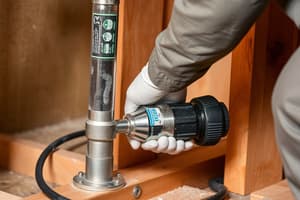Podcast
Questions and Answers
What nickname was commonly used for the Home Guard?
What nickname was commonly used for the Home Guard?
- Casual Combatants
- Weekend Defenders
- Saturday Night Soldiers (correct)
- Saturday Night Warriors
What was one of the first resources they lacked in the early days of the Home Guard?
What was one of the first resources they lacked in the early days of the Home Guard?
- Motor vehicles
- Weapons (correct)
- Training facilities
- Canteens
How did some units of the Home Guard demonstrate self-sufficiency?
How did some units of the Home Guard demonstrate self-sufficiency?
- By building their own training camps
- By training without any supervision
- By conducting drills without any weapons
- By creating their own canteens (correct)
What communication method did the Home Guard use to relay messages?
What communication method did the Home Guard use to relay messages?
What major advantage did the signaling skills of the Home Guard provide?
What major advantage did the signaling skills of the Home Guard provide?
What type of weapon did the Home Guard adapt from previous conflicts?
What type of weapon did the Home Guard adapt from previous conflicts?
Why did the Home Guard train in first aid?
Why did the Home Guard train in first aid?
What type of weapon became effective in the Home Guard's arsenal apart from usual rifles?
What type of weapon became effective in the Home Guard's arsenal apart from usual rifles?
What was the primary advantage of the Home Guard's guerilla tactics?
What was the primary advantage of the Home Guard's guerilla tactics?
Which weapon was most favored by the Home Guard for its effectiveness against enemy vehicles?
Which weapon was most favored by the Home Guard for its effectiveness against enemy vehicles?
What was the objective during practice raids conducted by the Home Guard?
What was the objective during practice raids conducted by the Home Guard?
How quickly could the Home Guard construct an improvised pontoon bridge?
How quickly could the Home Guard construct an improvised pontoon bridge?
What factor was crucial for the Home Guard to ensure they were always ready?
What factor was crucial for the Home Guard to ensure they were always ready?
What transformation did the Home Guard undergo during their training?
What transformation did the Home Guard undergo during their training?
Which type of explosives were commonly used by the Home Guard in their operations?
Which type of explosives were commonly used by the Home Guard in their operations?
What was the primary purpose of utilizing booby traps by the Home Guard?
What was the primary purpose of utilizing booby traps by the Home Guard?
Flashcards are hidden until you start studying
Study Notes
The Humble Beginnings of the Home Guard
- Known as "Saturday night soldiers," the Home Guard began with enthusiastic volunteers using dummy rifles and personal clothing due to a lack of uniforms.
- Despite looking unpolished, their commitment to national defense was unwavering.
Self-Sufficiency and Innovation
- Some units independently secured equipment by constructing cantens and collaborating with the women’s war service auxiliary.
- Volunteers trained in first aid and operated their own ambulances to improve preparedness and minimize casualties.
Mastering Communication and Signaling
- Signaling with lamps and flags enabled Home Guard units to communicate over distances of up to 500 miles quickly.
- Self-built signaling gear demonstrated their resourcefulness and mastery of communication.
Arming the Troops
- Initially started with insufficient rifles, the Home Guard eventually received limited supplies of tommy guns and repurposed weapons from past conflicts, including German machine guns.
- Guerrilla tactics taught members how to maximize their limited resources into an effective fighting force.
Improvised Weapons and Guerrilla Tactics
- Home Guards created homemade weapons like jam tin bombs and utilized various booby traps.
- The Molotov cocktail, made from simple materials, became a favored weapon for disabling enemy vehicles during training exercises.
Stealth and Tactical Operations
- Training involved stealth operations, where small teams eliminated enemy sentinels while minimizing their own casualties.
- Techniques included the use of gelignite bombs for target demolition under cover.
Bridging and Defensive Tactics
- The Home Guard was also skilled in constructing defensive structures, illustrated by the rapid assembly of a pontoon bridge from oil drums and planks within 15 minutes.
- This bridge facilitated river crossings under simulated combat conditions.
Prepared for Any Contingency
- Intense training sessions instilled readiness, allowing the Home Guard to respond promptly to any situation.
- Members trained to balance competence with courage, essential for the risks of war.
Defending New Zealand
- Transitioned from a casual volunteer group to a well-trained military unit, the Home Guard showcases dedication and adaptability.
- Their evolution reflects commitment to safeguarding New Zealand against potential threats through resourcefulness and relentless preparation.
Studying That Suits You
Use AI to generate personalized quizzes and flashcards to suit your learning preferences.




